Fair Work Action Plan 2022 and Anti-Racist Employment Strategy 2022: equality impact assessment
Equality Impact Assessment (EQIA) of the Fair Work Action Plan 2022 and Anti-Racist Employment Strategy 2022.
Appendix D Evidence and key issues
D.1 Population change
The latest estimate of the Scottish population is 5,479,900.[97] The population has grown 0.25% since mid-2020, which is 0.17 percentage points lower than the average annual growth from mid-2014 to mid-2019[98].
Contrary to previous years, population growth was recorded in many rural council areas while the population in the largest cities fell. For some rural regions, this year reversed a trend of population decline, such as Aberdeenshire and Argyll and Bute. While for other rural areas such as Highland and Perth and Kinross, which had seen steady growth or small decreases in recent years, the rate of growth increased[99].
D.2 Labour market statistics
D.2.1 Employment and unemployment
The employment rate in Scotland has fluctuated since 2004. As shown in figure D-1, a steep decline in employment was experienced between 2008-2012 in line with the recession of 2008/09, before rising again to its peak of 74.8% in 2019. The employment rate then decreased to 73.2% in 2021[100]
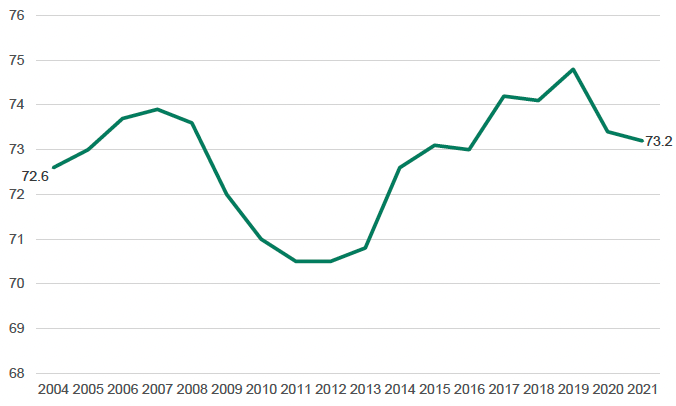
Source: Annual Population Survey, January to December data, ONS
The Business Register and Employment Survey Data identifies the number of jobs by industry sector across Scotland. In 2021, 15.3% worked in the health sector, whilst 10.0% worked in retail, and 8.3% worked in education.[101] Contrastingly, the sectors with the lowest levels of employment were property (employing 1.5% of the working population), motor trades (1.7%) and mining, quarrying, and utilities (2.4%).
Figure D-2 reveals that the Full-time and Part-time employment rates for those aged 16-64 have remained relatively stable over time. However, the Part-time employment rate consistently sits lower than the Full-time employment rate, fluctuating between 24.6% in 2004 and 24.3% in 2021 compared to 75.4% and 75.5% respectively.[102]
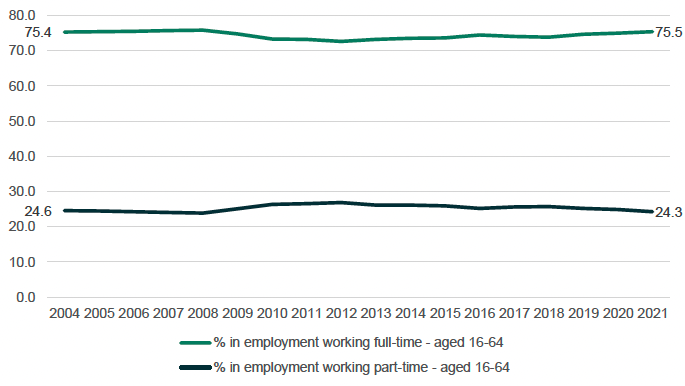
Source: Annual Population Survey, January to December data, ONS
The self-employment rate fluctuated between 2004 and 2021, reaching a peak in of 12.7% in 2016. In 2021, the self-employment rate was recorded at 11.0%.[103]
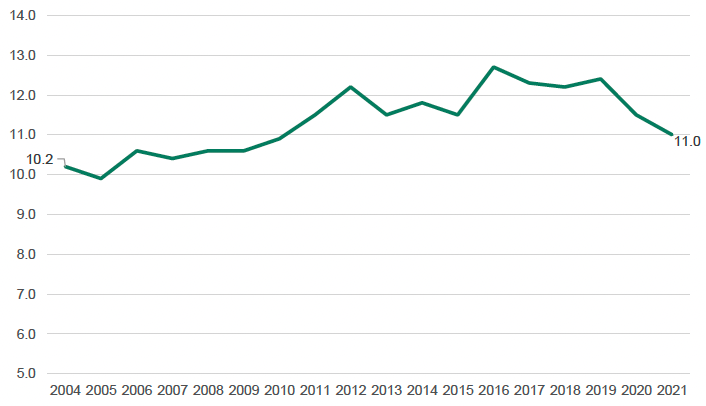
Source: Annual Population Survey, January to December data, ONS
Unemployment rate figures have fluctuated between 2004 and 2021. In 2008, the unemployment rate began to rise to a peak of 8.2% in 2011 before decreasing steadily until 2017. Between 2017-2021, the rate fluctuated annually reaching 3.9% in 2021. [104]
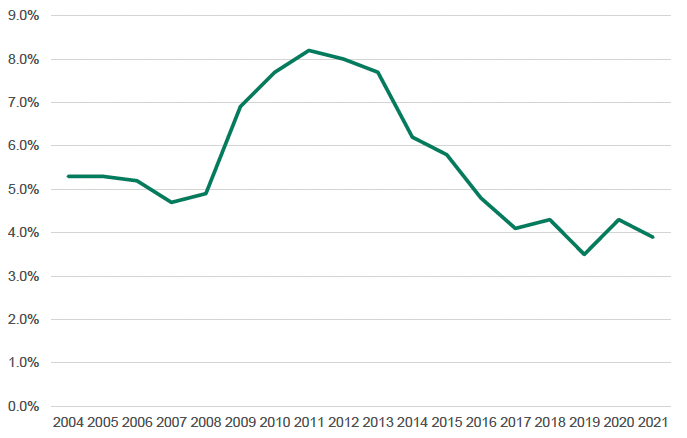
Source: Annual Population Survey, January to December data, ONS
D.2.2 Real Living Wage
The Real Living Wage is an hourly rate of pay established by the Living Wage Foundation which employers can voluntarily commit to. It is £10.90 across the UK, and £11.95 in London for people aged 18 or over. Unlike the UK Government's minimum wage ('National Living Wage' for over 23s – £9.50), the real Living Wage is the only wage rate independently calculated based on living costs. It is a voluntary base rate for employers who wish to go beyond the government minimum to demonstrate that they value their lowest paid staff. Living Wage employers pay all their directly employed staff aged 18 and over – as well as in scope regular third-party contractors – at or above the real Living Wage.
At present, according to the Employer Directory in Scotland there are over 2,900 real Living Wage employers, with concentrations seen in large cities such as Edinburgh and Glasgow.[105]
Social Enterprise Scotland has demonstrated the potential outcomes of paying the real Living Wage:[106]
- Over 59,000 workers currently employed by over 2,900 Living Wage employers in Scotland will receive a welcome pay boost because of the new rate; and
- As a result of rate increase, a full-time worker on the real Living Wage will earn £1,950 a year more than their current pay.
Further research from the Smith Institute reports a potential relationship between paying the real Living Wage and increased productivity and motivation in the workplace. Increased wages are also likely to have a positive impact on health and well-being through enabling workers to meet every day needs and increase resilience against financial crises. Therefore, these impacts could be acutely felt across low paid sectors and low income households.[107]
Figure D-5 below reveals the percentage of employees (18+) earning at least the real Living Wage in Scotland between 2012 and 2022, across all employees, public sector employees, private sector employees and employees within not for profit or mutual organisations.[108]
Records for all employees (18+) reveal that 81.2% were paid at least the real Living Wage in 2012, which increased 2.0 percentage points to 83.2% by 2019. In 2022, the percentage of employees who were paid the real Living Wage stood at 91.0%.[109]
In 2012, 96.5% of public sector employees were paid at least the real Living Wage and increased 0.4 percentage points to 96.9% by 2019. An increase was also recorded for private sector employees, from 71.7% to 75.4% in 2019. While data for not for profit organisations is only available for 2015-2022 and records an increase from 85.2% in 2015 to 85.4% in 2019. [110]

Source: Scottish Government, Annual Survey of Hours and Earnings (2022)
D.2.3 Zero Hours Contracts
A zero-hour contract exists when an employer is not obliged to provide employees with a minimum number of working hours.
Inappropriate use of these contracts can develop distrust, feels of insecurity, poor working environments and limited legal protection in employment which has been linked to generating poor mental health.[111] Workers require regular work to secure a consistent income stream to fund financial commitments. This ultimately reduces stress surrounding monies and increases focus on productivity.
Thereby, the benefits of excluding the use of zero hours contracts include:
- Lower staff turnover and recruitment expenses;
- Lower rates of staff absenteeism because of reduced stress levels;
- Increased productivity; and
- Improved employer reputation.
No inappropriate use of zero hours contracts is included in the Scottish Business Pledge and is a criterion of Fair Work First.
Figure D-6 illustrates the percentage of people in Scotland employed on zero-hour contracts from Oct-Dec 2004 to Oct-Dec 2022.[112] In Oct-Dec 2020, 3.1% of people were employed on a zero-hours contract, which increased to 3.2% by 2021. By 2022, this figure had increased again to 3.4%.[113]
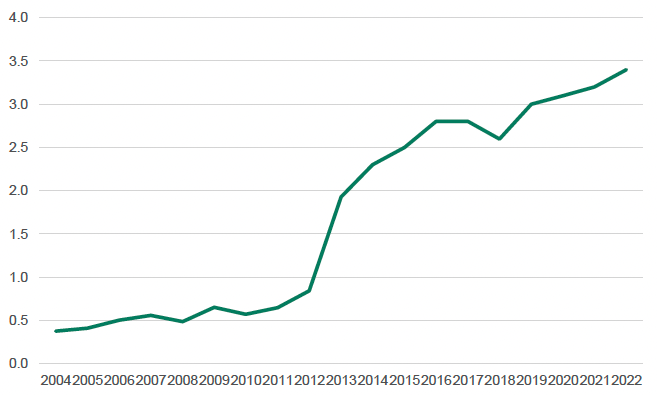
Source: Labour Force Survey, April to June data, ONS
D.2.4 Scottish Government workforce
The Scottish Government (SG) calculate annual diversity and inclusion estimates for its workforce. The latest data on core staff and experiences of different protected characteristic groups reveals that in 2021:
- The age groups 16-29 and 60+ were underrepresented in the SG workforce compared to Scotland's working age (16-65) population, while 16–29-year-olds are overrepresented in the application stage;[114]
- Women are overrepresented within the government's workforce compared to national ratios and on average were paid less than men;
- Women were also more likely to have received a promotion between 2020-2021 and be given an 'exceptional' or 'highly effective' performance rating than men;
- Transgender staff in SG felt less included, treated less fairly and experienced higher levels of discrimination than cisgender staff members;
- Disabled people were underrepresented across SG core staff members compared to the national average, and were more likely to be given lower performance rating and were paid less than non-disabled staff members;
- Ethnic minority[115] staff members are underrepresented in the government workforce despite being overrepresented in the application stage;
- Ethnic minority employees are also more likely to receive lower performance ratings and earn less than their white counterparts;
- Christian staff compose a lower percentage of applicants and joiners, while non-religious staff were more likely to have received a promotion between 2020-2021;
- LGB+ groups are overrepresented across the government workforce compared to the national average, however, have the same performance breakdown as heterosexual staff; and
- Staff members from a high or intermediate background felt more engaged and included than their counterparts, while those whose parents never worked reported more experiences of discrimination.
D.3 Protected Characteristic Groups
D.3.1 Age
This section considers children (0-16 years), younger people (aged 16-24 years old), working-age population (16-64 years) and older people (65+ years old).
Scotland has an ageing population. During the ten years to mid-2021, the number of people aged 65+ increased by an average of 1.82% per year (in comparison, the population as a whole increased by an average of 0.33% per year)[116]. The elderly population of Scotland is expected to grow further. By mid-2043, 22.7% of the population are projected to be of pensionable age (taking account of planned changes to the State Pension Age), compared to 18.3% in mid-2020. Similarly, the number of people aged 90 and over is projected to increase by 87% between 2020 and 2043.[117]
Mid-2021 population estimates show that 17% of the population are under the age of 16, 64% of the population are aged 16-64, and 20% of the population are aged 65 or over (rounded to the nearest percentage).[118]
In the two decades to mid-2021, the largest population growth was in the 65+ age group (+33%), compared to 16–64 year-olds (+6%) and children (-6%)[119].
Intra-regional age profiles identified the highest proportions of people aged 16-24 in the largest cities; areas neighbouring cities had the highest proportions of children; and rural and island areas have a higher representation of older people. All Scottish council areas experienced an increase in the older population, while the largest decrease in children and population aged 16-64 were rural and island communities. Figure D-7 shows the age breakdown of each Scottish council area for 2021.
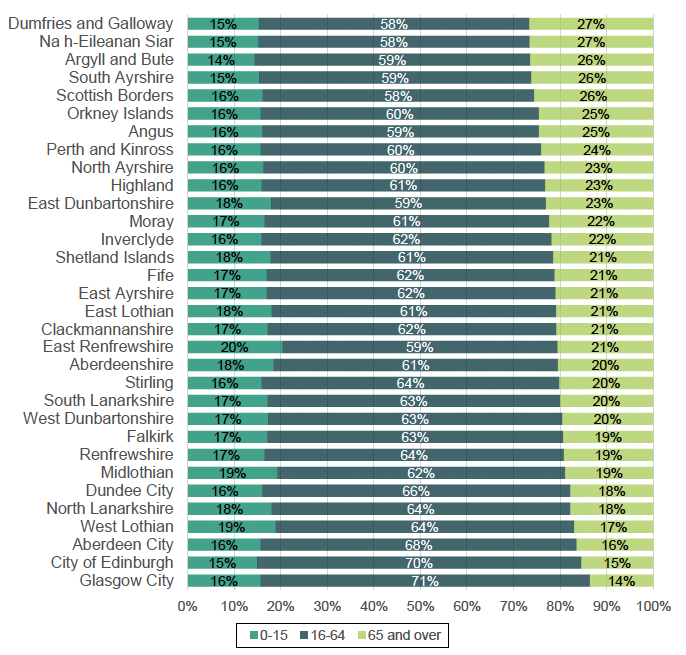
Source: NRS (2022) Mid-2021 population estimates. Figures are rounded so may not add up to 100%. Ordered by percentage aged 65+.
The age profile of Scotland is pertinent to addressing ageism in the labour market. As the workplace needs evolve, the rights of all workers to enter, continue and progress in the labour market should be protected.
D.3.2 Older people
The employment rate for 50- to 64-year-olds has decreased since Jan-Dec 2019 from 70.5% to 68.1% in Jan-Dec 2021.[120]
Employment in zero hours contracts for those aged 50-64 across the UK fluctuated between 2.3% in April-Jun 2020 and 2.1% in April-Jun 2022. While those aged 65+ had a higher rate of zero-hour contract employment in 2022 at 4.5%.[121]
A study of older people and employment in Scotland[122] identified that older people rely on employment for financial security, stable mental health, and career progression:
- Older people identified work as beneficial for mental health through providing social contact and physical activity;
- Respondents in lower-income employment were more likely to consider financial circumstances in their retirement plans. They were concerned about securing sufficient financial resources for a healthy standard of living without regular income from employment;
- The sample group revealed a desire to reduce working hours in the years leading up to retirement, despite the current lack of flexible working provisions in the labour market;
- Respondents in the over 50's age group recorded an interest in career development and training.
This evidence identifies barriers of ageism, undervalued skills and job insecurity experienced by older employees. Many respondents felt that they would experience discrimination when seeking new employment if they left their current job.
Further concerns of being made redundant prior to retirement age were expressed, predominantly amongst female respondents in third sector employment. Female participants also identified care responsibilities as having a knock-on effect in later-life employment. While low-income women over 50 who were single or divorced were more likely to experience cumulative negative effects of insecure labour markets, caring responsibilities, and health problems.
Key issues:
- Scotland has an ageing population.
- Older people are at risk to the systemic barrier of ageism which undervalues the skills and contributions of older employees.
- Older people disproportionately experience job insecurity, redundancy, and undervalued skills in the labour market.
D.3.3 Young people
The estimated employment rate for young people (aged 16-24) in Scotland was 54.0% in Jan-Dec 2021. While this is an increase from 2020, the employment rate is still lower than the rate recorded before the Covid-19 pandemic. [123] The pandemic disproportionately affected the employment of young people with people aged 16-24, experiencing a significant rise in unemployment and higher rates of furlough than all other age groups.[124] Further, across the UK, the percentage of young people (16 to 24 year olds) employed on zero-hour contracts has increased from 9.9% in Oct-Dec 2021 to 11.6% in Oct-Dec 2022[125] and 18 to 24 year olds are less likely to be paid the real Living Wage.[126]
This reflects the overrepresentation of young people in sectors most affected by the pandemic, such as accommodation and food. This trend reflects the experiences of previous recession periods, demonstrating the precarious position of young people in the labour market.
There are also gendered trends for young people in employment. The estimated employment rate for young men in 2021 was lower than women at 52.8% compared to 55.2% respectively.[127]
Key issues:
- Young people disproportionately experienced economic impacts as a result of the Covid-19 pandemic.
- Young people are overrepresented within precarious positions in the labour market, including zero hour contracts and low paid jobs.
- Young women have a higher employment rate than young men.
D.3.4 Disability
The 2021 Scottish Health Survey reported that 47% of adults live with a long-term health condition, 34% of which were limiting. [128] The incidence of both limiting and non-limiting conditions increases with age, from 18% amongst 16–24-year-olds to 60% among years 75+.
Disabled people experience the largest employment gap in the labour market. Despite the disability employment gap reducing from 37.4% in Jan-Dec 2016 to 31.2% in Jan-Dec 2021, the employment rate for disabled people is still 31.2 percentage points lower than for non-disabled people (49.6% and 80.8% respectively).[129]
As shown in Figure D-8 below, the disability employment gap increases with age, from 21.2% for 16–24-year-olds to 36.3% for 35–49-year-olds, before decreasing to 33.2% for 50-64-year-olds. The employment gap amongst men is higher than women across all age groups, especially those aged 35-to-49-years-old at 41.8%.[130]
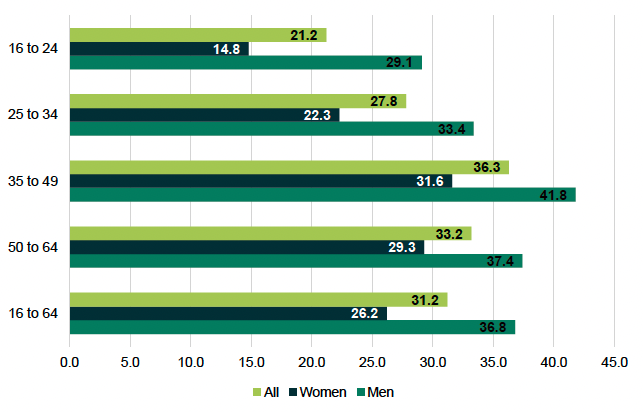
Source: Annual Population Survey, January to December data, ONS
Disabled people experience systemic barriers in the labour market driven by disablism.[131] Disabled people are being denied the same access to employment as non-disabled people, while those who do access employment experience poor employment practices and a lack of support from their employers, which limits their opportunities for progression in the workplace.[132]
Systemic disablism in the labour market discriminates against disabled people who tend to be perceived as passive recipients of care rather than active members of society.[133] The Scottish Government policy approach is based on the social model of disability, which works to reverse this stereotype through recognising society's inability to provide for disabled needs rather than blaming the impairment for disadvantages.
Young disabled people are particularly at risk to unemployment when transitioning from school to further education, apprenticeships, or work. They are more likely to have trouble in accessing the appropriate support, resources, and training.[134] While 89% of disabled school leavers have positive destinations, a lower proportion of disabled people enter higher education or obtain a university degree and are more likely to have low or no qualifications at Scottish Credit and Qualification Framework (SCQF) level 4 than non-disabled people.[135]
Disabled people are more likely to experience long-term social and employability impacts from Covid-19 than non-disabled equivalents. Disabled adults were more likely to report that their well-being is affected by Covid-19 than non-disabled adults from March 2020-December 2021, including low life satisfaction, low levels of happiness, high levels of anxiety and low levels of feeling worthwhile.[136] Disabled adults were also more likely to feel lonely often, always, or some of the time.
The economic impacts of Covid-19 were more likely to affect disabled people who were more likely to work in sectors affected by Covid-19 and experience financial insecurity following the pandemic. Further, disability is identified as one of the most significant factors influencing a person's return to work after being unemployed, especially following the Covid-19 pandemic.[137]
Key issues:
- Disabled people experience the largest employment gap in the labour market.
- Disablism may generate structural barriers to accessing the labour market for disabled people.
- Young disabled people undergoing transitions from school are particularly at risk to unemployment.
- Disability is one of the most significant factors affecting chances of return to work, especially in the recovery from Covid-19.
D.3.5 Gender Reassignment
There are no official statistics relating to gender reassignment in Scotland as the Census has previously only collected data relating to sex at birth. However, in the 2022 Census, people will be able to self-identify as male or female, allowing transgender people to answer a different sex to that on their birth certificate without the need for a Gender Recognition Certificate. A voluntary question about trans status or history will also be included for those aged 16 or over. This will provide an option to identify as non-binary.
Transgender identity is one of the five groups or protected characteristics covered by the hate crime legislation. Nearly half of transgender persons in Scotland experienced a transphobic hate crime or incident in the years before 2017, according to estimates.[138] However, the total number of charges for hate crimes against transgender people comprises only 0.8% of all hate crimes. For many transgender people, concerns about discrimination and harassment are part of their day to day lives.
Key issues:
- Limited information and data are available on the transgender population including the lived experiences with this group.
- Transgender or gender non-conforming people may have concerns about accessing employment for fear of being harassed or discriminated against.
D.3.6 Pregnancy and maternity
The number of births registered over recent years has fluctuated, from their lowest point in 2002 (51,270) since records began in 1855, to a high in 2008 (60,041). [139] Since 2008, the number of births has decreased year on year to 47,249 live births in 2021/22.[140]
Public Health Scotland's national birth statistics for 2021/22 revealed that an increasing percentage of women conceive their first child at an older age. In 2021/22, 16% of women aged 35 and over were experiencing their first birth, compared to 13% in 2011/12.[141]
In 2020, the teenage pregnancy rate reached its lowest level since reporting began at 23.9 per 1,000 women.[142] While a reduction in teenage maternity was largest across the most deprived areas, these regions still experienced a rate five times higher than the least deprived areas (44.9 and 9.0 per 1,000 women respectively).
Women living in the most deprived areas continued to represent a higher proportion of births. In 2022, 24.3% of births were to women in the most deprived area, while only 16.9% of births were to women in the least deprived areas.[143]
Public Health Scotland also highlight a relationship between deprivation and the health of pregnant women and new-borns. Women living in deprived areas were more likely to conceive at a younger age, be overweight and deliver low-birthweight babies compared to those from less deprived areas. This increases the risk of short and long-term health problems as a consequence of childbirth, which could extend maternity leave and ultimately exacerbate existing barriers to returning to work for those most at risk to poverty.
Further ethnicity data reveals that 77.8% of births were recorded as White, 8.3% as non-white racialised minorities and 13.9% from 'unknown' ethnicities. Across the ethnic groups, minority ethnic maternities were overrepresented in the most deprived areas. African maternities represented the highest proportion of pregnancies in the most deprived area at 48.6%, compared to 23.7% for white maternities.
Currently, eligible employees can take a maximum of 52 weeks maternity leave.[144] While Statutory Paternity Leave is either one or two consecutive weeks' leave which must finish within 56 days of the birth. Extra leave is available if a partner returns to work or an employer offers more.
Pregnant women may experience pregnancy and maternity discrimination when falling pregnant, experiencing illness related to pregnancy, exercising the right to maternity leave or returning from maternity leave. Employers may directly disadvantage pregnant employees or indirectly make working life particularly challenging. For example, employers may refuse to recruit, demote, dismiss, exclude from promotion, or refuse a pay rise to pregnant employees.
There is a lack of recent studies reporting on women's experiences of maternity discrimination; therefore, while the following research studies may not reflect the immediate situation, it is important to acknowledge the potential impacts of pregnancy on women in the labour market.
The Equality and Human Rights Commission (2015) interviewed 3,254 mothers and highlighted the following experiences:
- 50% of mothers experienced a negative impact on job security, status, or opportunity;
- 42% of mothers experienced health and welfare risks through being unable to work flexibly and being discouraged from attending midwife appointments during working hours;
- 20% of mothers reported a loss of finances through exclusion from promotions or reduced salary because of falling pregnant; and
- 11% of pregnant women felt forced to leave their job, including dismissal, redundancy, and discrimination.[145]
Key issues:
- Pregnant women may experience discrimination during pregnancy and when returning from maternity leave, including job insecurity, exclusion from opportunities and dismissed working adjustments.
- Pregnant women living in the most deprived areas may experience greater barriers in the labour market because of higher health risks during and after pregnancy.
- Racialised minority women are overrepresented across pregnancies in the most deprived areas.
D.3.7 Race
The last census (2011) found that most of the population in Scotland was White, with approximately 60% of local authorities having a white population of more than 98%.[146] Only Glasgow City has a white population of less than 90%. "Asian, Asian Scottish or Asian British" was the second largest ethnic group in Scotland (2.7%), with the largest populations being in Glasgow (8.1%), City of Edinburgh (5.5%) and East Renfrewshire (5.0%). The smallest minority ethnic group in Scotland at the last Census was "Caribbean or Black", which made up only 0.1% of the total population.
Race is one of the five groups of protected characteristics covered by the hate crime legislation and racial crime is the most reported hate crime with 3,249 charges reported in Scotland in 2017-18.[147] Racial discrimination, harassment, or abuse create day-to-day barriers for racialised minority groups who are more likely to be subject to hate crimes.
In the labour market, racialised minority groups experience disadvantage due to structural racism. This can generate poorer outcomes, including lower employment rates, over-representation within low paid sectors with few opportunities for career progression, higher risk of poverty and experiences of racism in the workplace.[148]
Racial discrimination in the labour market can be reflected through the employment rate of the white population consistently exceeding that of racialised minority populations. In 2021, the employment gap for ethnic minorities was 11.7 p.p., and the unemployment rate was estimated at 6.5%[149] compared to 3.8% for their white counterparts[150].
The annual population survey (Jan-Dec 2021) breaks the employment gap down by age and gender. In 2021, the employment gap was largest amongst those aged 16 to 24 at 19.6 p.p.[151], followed by ages 25-34 (18.9 p.p.) and 35 to 49 (17.9 p.p.). While those aged 50-64 experienced a higher employment rate amongst minority ethnic groups than the white population, generating an employment gap of -8.4 p.p.. All age groups have experienced a decrease in their employment gap since 2020.[152]
In terms of gender, the ethnicity employment gap is wider for women than men. In 2021, the ethnic employment gap for women was estimated at 23.1 p.p. compared to only -1.5 p.p. for men. The employment gaps for women has increased since 2020 and the gap for men has reversed. In 2020, the gap for women was 15.8 p.p. and 2.8 p.p. for men.[153]
Further evidence of racial discrimination in the labour market is the ethnicity pay gap. The Annual Population Survey published in 2022 reveals that the ethnicity pay gap was 10.3% in 2019.[154]
Evidence from the Trade Union Congress demonstrates that regardless of educational attainment, racialised minorities experience a pay gap with white workers.[155] This pay gap is widest at degree level. The most recent statistics available (2016) reveal that black workers with degrees earn 23.1% less than white workers with degrees. While black workers with A-levels earn 14.3% less and those with GCSEs earn 11.4% less than their white peers. Therefore, at all levels of education ethnic minorities face systemic disadvantage in the labour market.
In terms of intersectionality, racialised minority women are more likely to be employed in part time and insecure roles and have been 'left behind' in pay gap progress both within and between ethnic groups.[156] For example, Black African women earn 24% less than white British men, while Indian women experience the largest pay gap with men in their ethnic group at 16.1%. Pakistani and Bangladeshi women experience the biggest gap with white males (26.2%), however there is a significantly smaller gap with men in their ethnic group (5.5%) revealing that Pakistani and Bangladeshi men are also experiencing a poverty trap of low paid work.
Racialised minorities are also more likely to have suffered unemployment during the Covid-19 pandemic due to their high representation in low-paid work in 'shut down' sectors, such as hospitality and key workers. Racialised minority groups, particularly from black backgrounds, were over-represented amongst key workers during the Covid-19 pandemic (including those in health and social care, security, wholesale and retail and bus, coach and taxi drivers)[157] and were least likely to work from home, with just 8% of those in the accommodation and food sector in the UK reporting home working.[158] Racialised minorities also reported feelings of lost governmental support during the Covid pandemic. [159] This creates additional barriers to emerging training opportunities, which without employer's encouragement in recruitment, could exacerbate racial inequalities in Scotland's labour market in the move to a net zero economy.
Key issues:
- Racialised minority groups face systemic barriers in the labour market, including racial discrimination, harassment and abuse which generate poorer outcomes than average.
- Ethnicity data in the labour market is limited, minimising an evidence base for racial discrimination.
- Minority ethnic women and those aged 25-34 experience the largest employment gaps.
- Ethnic minorities disproportionately faced unemployment during the Covid-19 pandemic, especially key workers.
D.3.8 Religion or Belief
In the 2011 Census, over a third of the Scottish population (36.7%) stated that they have no religion: this is the largest category within the 2011 census.[160] Next to this, 32.4% of people identified the Church of Scotland as their main belief and 15.9% identified the Roman Catholic Church. 7.0% of the Scottish population comprise the group, "Other Christian". There are several other religious minorities in Scotland, with Muslim being the largest of these at 1.5%.
Religion or belief is one of the five groups or protected characteristics covered by the hate crime legislation. Sectarianism also remains an issue in Scotland. Roman Catholicism is the religion that was most often the subject of reported abuse, with 319 charges for 2017-18.[161] Protestantism and Islam are the religions that were subject to the next highest number of aggravations in 2016-17 (174 and 115 charges respectively) followed by Judaism (21 charges). These groups may have more concerns about experiencing discrimination, assault, or harassment based on religious identity.
Key issues:
- Discrimination, assault, or harassment of the basis of religious identity may affect people of certain religious groups more than others, and this may affect their experience in the labour market.
D.3.9 Sex
Mid-2021 population estimates reported that 48.8% of Scotland's population are male and 51.2% are female. [162]
Evidence also reveals a higher percentage of females to males in the older age group, representing a longer life expectancy amongst women. The most recent life expectancy data, from 2019-2021, reveals an average life expectancy at birth of 76.6 years for males and 80.8 years for females.[163]
The employment rate for men is higher than for women across all age groups, except for those aged 16 to 24. On average, in Jan-Dec 2021 the working-age population of Scotland (16-64 years), women had a lower employment rate of 70.7% compared to men at 75.8%.[164] Women across the UK also represent a higher proportion of employees on a zero-hour contract, at 3.9% compared to 3.0% of men.[165]
Systemic barriers in the labour market contribute to these inequalities between men and women. Women tend to experience gender discrimination in recruitment, promotion opportunities and pay, with 43% of young women feeling they did not have equal access to work in 2021.[166]
Occupational segregation is a particular barrier faced by women in the labour market. This refers to the division of roles based on gender led by the socially ascribed position of men as dominant and socially constructed segregation into male and female-dominated occupations.[167] Gender divisions largely reflect the historic role of women as primary caregivers in a household and social attitudes towards 'women's work' which moves women into low-paid care professions and undervalued sectors.
Women disproportionately carry out unpaid caring responsibilities which may minimise availability for paid employment, restrict career choices and limit locations of employment while significantly impacting women's personal wellbeing.[168] Caring responsibilities are also likely to influence unpaid breaks from employment which impact household income and generate barriers of entry when returning to the labour market. The pressures of caring responsibilities are exacerbated for single parents who experience a greater risk of poverty. Therefore, caring responsibilities generate labour market inequalities and can be attributed to the gender pay gap.
Occupational segregation, alongside other labour market attitudes, contributes to the gender pay gap.[169] Although the gender pay gap (for median full-time hourly earnings (excluding overtime)) in Scotland has been lower than the UK since 2003 and has typically been reducing over time. In 2022, the Scottish gender pay gap stood at 12.2% for all employees and 3.7% for full-time employees, compared to the UK at 14.9% and 8.3%, respectively.[170] Real Living Wage statistics also reveal gender disparities, with a higher percentage of men being paid the real Living Wage compared to women. In 2022, 92.5% of men were earning the real Living Wage compared to 89.7% of women.[171]
Close the Gap further analysed the gender pay gap by occupational groups for 2020.[172] This revealed that the gender pay gap was highest for skilled trades at 26%, followed by process, plant, and machine operatives at 19.5% and managers, directors, and senior officials at 14.9%. While caring, leisure and service occupations had the lowest gender gap (2.5%), followed by sales and customer services (5.6%). Indicating that typically male dominated roles discriminate most against women in terms of pay. The significant pay gap within managerial positions demonstrates the barriers women face in accessing senior roles in the workplace mentioned earlier.
Intersectional analysis of the gender pay gap is limited by data because women are not a homogenous group. There are gaps in analysing how ethnicity and gender intersect to influence pay gaps.
The Young Women's Movement (YWCA) recognise intersectional inequalities faced by young, racialised minority, disabled women, and women with caring responsibilities in the labour force, who all report exclusion from labour market opportunities due to the following perceptions of their characteristics.[173]
- Young women felt excluded from the labour market due to perceptions of inexperience;
- Racialised minority women reported fear of discrimination due to their status as a 'young immigrant woman', requiring a visa to work or because they have a foreign last name.
- Young disabled women felt excluded from development opportunities due to adjustments required by the employer;
- Some disabled women have been advised to avoid disclosing disabilities until they have been offered a role or surpassed their probation period; and
- Mothers and women caring for relatives reported being restricted to part-time work and consequently facing exclusion from the same promotions and development opportunities as full-time staff.
The YWCA also reported that the economic impacts of Covid-19 have disproportionately affected young women and exacerbated pre-existing labour market inequalities. Employment stability for 51% of young women was affected by the pandemic, including 25% who were furloughed, 8% made redundant and 20% struggling to find employment. While 40% of those in employment felt insecure and 60% had to change their career plans.
Further, the cumulative impacts of the pandemic and decline in the job market generated harmful impacts on women's mental health. Over half of young women felt stressed and anxious when applying for new job opportunities, and a quarter felt unsupported by their employer to look after their mental health.
Key issues:
- Women have a lower employment rate compared to men, and a higher percentage of women are employed on zero-hour contacts.
- Women face systemic barriers in the labour market which generate underrepresentation, occupational segregation, and exclusion from progression.
- Intersectional labour market inequalities are identified for young women, racialised minority women, disabled women, and women with caring responsibilities.
- The Covid-19 pandemic disproportionately impacted young women's job security, career development and mental health.
D.3.10 Sexual Orientation
In the Scottish Surveys Core Questions 2019, 94.2% of adults identified with being heterosexual and 2% identifying as lesbian, gay, bisexual, or other (LGBO). The remaining respondents answered, "Don't Know". It is believed that this survey may undercount the number of adults self-identifying as LGBO as they may not feel comfortable with the interviewer.
Sexual orientation is one of the five groups of protected characteristics covered by the hate crime legislation and the most pertinent issue faced by this group relates to fears about intimidation, violence and/or abuse. It is estimated that 17% of LGBT people, and one in four disabled LGBT people, experienced a hate crime in the twelve months prior to 2017, an increase from 9% in 2013. Charges for hate crime charges aggravated by sexual orientation have also increased, despite 87% of homophobic, biphobic or transphobic hate crimes being left unreported.[174]
Furthermore, according to the Equality Network, 79% of LGBT people in Scotland have experienced prejudice or discrimination in the last year. When it comes to accessing services, one out of every four people has experienced discrimination.[175]
Key issues:
- Limited information and data is available on the LGBT population including the lived experiences of this group.
- People in this group may be concerned about accessing employment for fear of harassment or discrimination.
D.4 Deprivation
The extent of deprivation is measured by the 2020 Scottish Index of Multiple Deprivation (SIMD) (Scottish Government, 2020b). It provides an overall deprivation ranking for data zones (DZs) across Scotland by across seven domains. These domains include aspects such as income, employment, health, education, crime, access to services, and housing; and are the key factors which influence a person's experience of deprivation.
The areas showing the highest concentrations of deprivation tend to be around urban areas and their suburbs. That is not to say that people in rural areas experience lower of deprivation per se, just that deprivation in these areas is more dispersed (as shown in Table 3-1).[176] According to the SIMD in 2020, the highest percentage of deprivation is found within Glasgow City, at 45.44% of data zones among the 20% most deprived areas locally, followed closely by Inverclyde at 44.74%.
| Local authority area |
No. Of '20% most deprived' data zones |
Local share (%) |
|---|---|---|
| Glasgow City |
339 |
45.44% |
| Inverclyde |
51 |
44.74% |
| North Ayrshire |
74 |
39.78% |
| West Dunbartonshire |
48 |
39.67% |
| Dundee City |
70 |
37.23% |
| North Lanarkshire |
153 |
34.23% |
| East Ayrshire |
51 |
31.29% |
| Clackmannanshire |
18 |
25.00% |
| Renfrewshire |
56 |
24.89% |
| South Lanarkshire |
88 |
20.42% |
| Fife |
97 |
19.64% |
| South Ayrshire |
28 |
18.30% |
| Falkirk |
35 |
16.36% |
| West Lothian |
35 |
14.64% |
| Stirling |
15 |
12.40% |
| City of Edinburgh |
71 |
11.89% |
| Argyll and Bute |
13 |
10.40% |
| Aberdeen City |
29 |
10.25% |
| Highland |
30 |
9.62% |
| Dumfries and Galloway |
19 |
9.45% |
| Midlothian |
10 |
8.70% |
| Angus |
12 |
7.74% |
| Scottish Borders |
9 |
6.29% |
| East Lothian |
8 |
6.06% |
| Perth and Kinross |
11 |
5.91% |
| East Renfrewshire |
7 |
5.74% |
| East Dunbartonshire |
5 |
3.85% |
| Moray |
4 |
3.17% |
| Aberdeenshire |
9 |
2.65% |
| Na h-Eileanan an Iar |
0 |
0.00% |
| Orkney Islands |
0 |
0.00% |
| Shetland Islands |
0 |
0.00% |
These statistics provide a measure of 'relative deprivation', not affluence. As such, it is important to recognise that not every person in a highly deprived area will consider themselves to be deprived and likewise, that there will be some people experiencing deprivation who live in the least deprived areas. For example, over 50% of people on low incomes do not live in the 20% most deprived areas in Scotland.
In terms of protected characteristics, areas with a higher level of deprivation tend to accommodate more people with a long-term limiting condition, including disabled people. In the most deprived areas in Scotland, 48% of adults live with a limiting condition while only 25% of adults live with a limiting condition in the least deprived areas.[177] Disability and socio-economic disadvantage are clearly linked, and any potential economic cost associated with the RAP and ARES actions could impact these individuals.
D.5 Poverty
D.5.1 Relative poverty
In 2017-2020, 17% of Scotland's population were living in relative poverty before housing costs and 19% after housing costs.[178] As shown in figure D-9, relative poverty rates have fluctuated from the highest figures recorded in 1994-1997 to the lowest in 2011-2014. Since then, rates began to rise again until stabilising in 2015-2018.
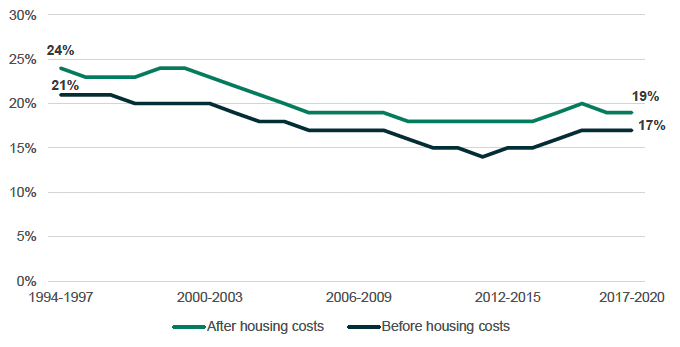
Source: Scottish Government (2021) Poverty and Income Inequality
In terms of protected characteristics, relative poverty is more prevalent amongst:
- Young people (16–24-year-olds)
- Single mothers
- Single, divorced, or separated adults
- Racialised minority groups
- Muslims
- Household with disabled member
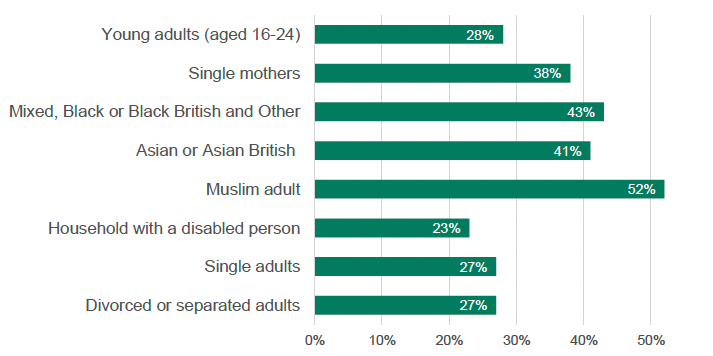
Source: Scottish Government (2021) Poverty and Income Inequality
D.5.2 Child poverty
The latest records (2017-2020) estimate that 21% of children were living in relative poverty before housing costs and 24% after housing costs.[179] Following a steady decline between 1994-1997 and 2010-2013, child poverty rates have been rising again.
Figure D-11 identifies the priority groups which are known to have a greater risk of child poverty. Most households with children experiencing child poverty will belong to at least one of these groups.
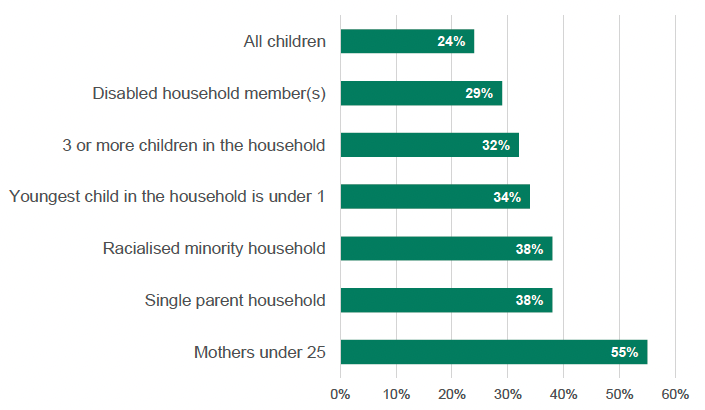
Source: Scottish Government (2022) Tackling child poverty delivery plan 2022-2026[180]
D.5.3 In-work poverty
While employment is a way out of poverty and families with all adults in full-time employment have a lower risk of poverty, if a job does not pay well or the employees are unable to work enough hours the risk is greater.
Relative in-work poverty has remained relatively stable since the first records in 1994-1997. In 2017-2020, relative poverty stood at 16% before housing costs and 19% after housing costs.
In terms of protected characteristic groups, two thirds (68%) of children experiencing relative poverty, after housing costs, live in working households while only 32% live in workless households.
Further, the CRER evidence that racialised minority communities face a poverty trap of low paid employment and minority ethnic households have 10 times less 'wealth' than British households in terms of savings or assets.[181] Further, lower employment rates across racialised minority groups – especially women – means households are less likely to have two income earners to buffer for crises. The indication that racialised minorities have a lower ability to save generates disproportionate vulnerability to the long-lasting impacts of Covid-19 which may contribute to a rise in poverty.
D.5.4 Cost of living
The Joseph Rowntree Foundation's 'Poverty in Scotland 2022' publication reports on the societal impact of the recent cost of living crisis.
A poll of lived experience in Scotland reveals that:
- One-third of people either have no savings or under £250, rising to two-thirds for unemployed households and 70% of single parent households;
- One in 20 households are behind on rent or mortgage payments;
- 65% of households have cut back on one essential and 26% have cut back on three or more essential goods, while three in four households have cut back on the basics;
- 44% of households heated their homes less than they needed to reduce cost; and
- 23% of households felt financially insecure, with renters feeling more insecure than homeowners.
A consequence of the financial pressures of the living crisis has been a deterioration on mental health. Key households reporting negative impacts on mental health include families with a child where a household member has a disability (74%), single-parent families (69%) and households with a baby (80%). Further, half of respondents reported a negative impact on their social life which threatens to repeat the isolation of the Covid-19 pandemic.
Key issues relating to poverty:
- Some protected characteristic groups are more at risk to both relative poverty and child poverty, including racialised minority households, single parent households and households with a disabled member.
- In-work poverty is disproportionately felt across racialised minority households because of the poverty trap of low paid employment and higher levels of unemployment, especially amongst racialised minority women.
- The cost-of-living crisis has generated precarious financial situations for unemployed households, renters, and single parents.
Contact
There is a problem
Thanks for your feedback